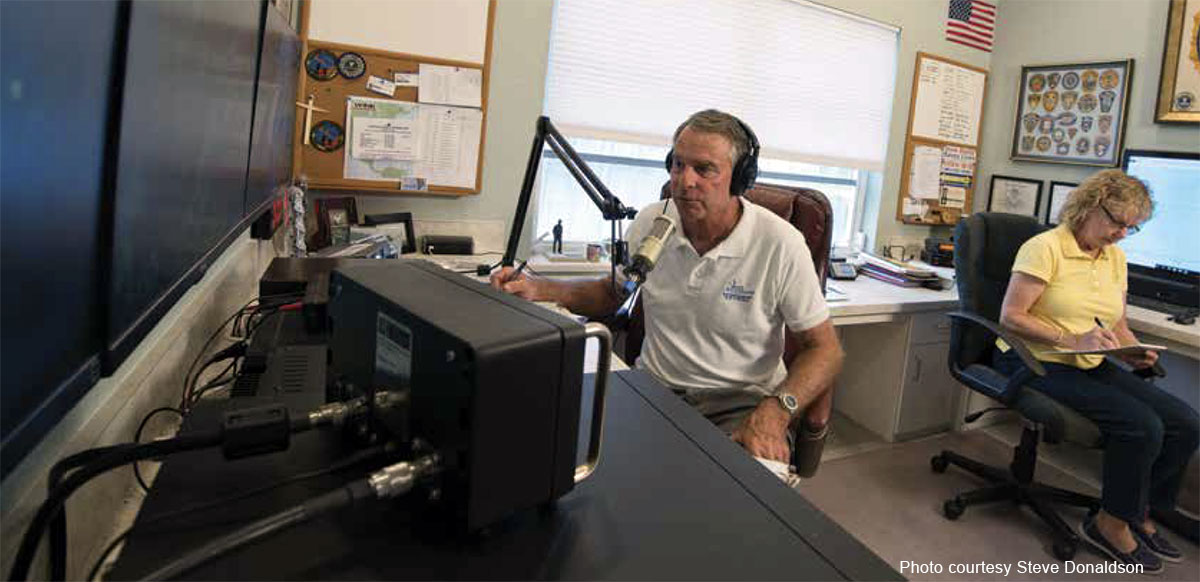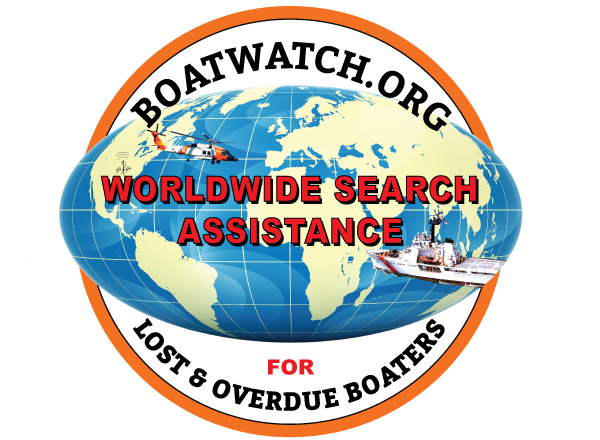Resources
The mission of BoatWatch.org is to maintain a worldwide network of resources to aid mariners that are missing or overdue; have a boat stolen; or to whom urgent messages need to be relayed.
Safety Resources
File a Float Plan
This float plan should be filed with the person or persons who know you and your boat best and will be able to assist authorities and others in looking for you. The float plan is not to be filed with the Coast Guard.
Update Your EPIRB
Update your EPIRB information and registration with contacts that know you well and your boat.
Safety at Sea Information
Cruiser Organization’s with Safety Seminars
SSCA – Seven Seas Cruising Association
Search and Rescue Contacts World-Wide
Find contact information for centers worldwide. Some very interesting and interactive maps here.
SAR Contacts – https://sarcontacts.info/
Radio Schedules & Links
Docksideradio.com has the following links/resources:
Under his section on Links, he has several great links:

About Ham Radio Networks
To operate an amateur radio – ham radio – maritime nets, you must be a properly licensed amateur radio operator to transmit on these frequencies. But you are always welcome to listen! To get an amateur radio/Ham radio license,
In an emergency, FCC rules permit anyone, licensed or not, to use any frequency to summon help. All boaters with high frequency SSB radios aboard should know that the 20 meter amateur frequency of 14.300 MHz is active for about eighteen hours a day and is always available for emergency assistance. If you have a SSB radio, all you need is a license for the radio which is easily obtainable.
14.300 MHz has become a very well known frequency in the Amatuer Radio world. There are three major nets in the Western Hemisphere that operate on 14.300 MHz.
From early morning until late evening the frequency is busy with traffic of one form or another. Beginning at 0700 ET daily, The Intercon Net, formally know as The Intercontinental Amateur Traffic Net, starts out the day. Intercon runs until 1200 ET before handing the frequency over to The Maritime Mobile Service Network.
The MMSN, which also runs daily, operates from 1200 ET until 9 PM EST / 10 PM EDT or 0200 UTC.
After The MMSN raps up The Pacific Seafarers Net begins operation at 10 PM EST / 11PM EDT or 0300 UTC and runs various lengths of time, depending on traffic load, but usually about 2 hours or less.
Let’s take a brief look at each net:
The Intercon Net
According to Intercon’s website, this net’s mission is three-fold:
- To promote goodwill and friendly relations among radio operators everywhere.
- To handle third party traffic and information between individuals in any country where such traffic handling is permitted by treaty or mutual agreement.
- To provide a means of emergency communications to any location where the normal means are disrupted by local disaster such as fire, earthquake, storms, floods and terrorist activity.
Intercon is probably the least structured, or formal, net of the three. Make no mistake about it, some very important and critical traffic has been handled on Intercon over the years, but a little more “ragchewing” is acceptable.
The Pacific Seafarer’s Net
Pacsea handles traffic with vessels mainly in the Pacific Ocean. Utilizing stations from North America to New Zealand, Australia and across the Pacific, Pacsea takes position reports and weather observations from vessels.
Pacsea NCS’s use special software to post positions on the internet and send observed weather conditions to the weather forecasters for the Pacific. Friends and family may then track their vessel of interest online.
The first 25 minutes of the net is open to general check-in’s. After that, the roll call portion of the net begins and it is very structured from that point. Any station is welcome to assist as a relay for Pacsea. If your area of interest is the Pacific, check out The Pacific Seafarer’s Net.
Cruiseheimers Net
The Cruiseheimers Net is a morning marine single sideband (SSB) voice communications network operated by volunteer cruisers. The purpose of this net is to help cruisers connect, communicate and provide a place to get information. The net starts out listening for emergency or priority traffic. Then goes into general announcements, followed by calls for vessels short of time or underway, then takes position reports from vessels wishing to check in from their locations.
Cruiseheimers broadcasts on 8152 kHz at 0830 hrs Eastern Time, with alternative frequencies of 8146 kHz and 8164 kHz.
“Doo-Dah Net
The Doo Dah Net is a logical follow up to the morning Cruiseheimers Net. It is a SSB Network operated by Dick Giddings, also known as “St. Jude,” (FCC Call sign KNC) from Dover, North Carolina, and operates on 8152 kHz (alternates of 8146/8164 kHz) at 1730 hrs Eastern Time.
The net starts out listening for emergency and priority traffic, then takes position reports from vessels on passage, transitions into vessels recently arrived, and concludes with any boat to boat traffic.
The Maritime Mobile Service Network
The primary purpose of this net is for handling traffic from maritime mobiles and overseas-deployed service personnel. MMSN also assists missionaries and persons working abroad.
The MMSN has a more formal or structured format than Intercon. Since vessels at sea generally have barefoot or less rigs, running on battery power with wire or vertical antennas, their signals may be hard to copy at times. The Net Control Stations frequently ask all stations to standby while calling for maritimes only that may wish to check in. Also, offshore weather information is usually read at about 30 minutes past the hour. Ragchewing is considered a no-no during MMSN.
Any station can check into the MMSN when the NCS is asking for general check-in’s. If you would like a signal report, audio report or just to say you are “riding along”, this is the time to check-in.
Waterway Radio & Cruising Club Net
The Waterway Radio and Cruising Club is an association of amateur radio operators who also share an interest in recreational boating. The Waterway Net, which is sponsored by the Waterway Radio and Cruising Club, meets on the air every morning of the year for about an hour starting at 0745 ET on a frequency of 7.268 MHz LSB.
The main purpose of the Waterway Net is to encourage amateur radio communications to and from boats with an emphasis on safety and weather information. Position Reports help keep live-aboards and cruising boats in touch with families and friends and Float Plans provide a strong measure of safety for off-shore passage makers.
Begun in the early 1960’s, the Waterway Net is one of the oldest, continuously operating nets in amateur radio. Today the WRCC has around four hundred dues paying members and anyone holding an Amateur Radio License of any class is eligible to join. Membership in the WRCC is not a prerequisite for participation in the Waterway Net, but a general class or higher license is required.
The Waterway Net is a controlled net. It is recommended that one listen for a while to learn the Net Procedures, but anyone with a general class license or above is invited to check in at the appropriate time or to join in on the special interest nets that often follow.
SSCA HF Radio Service
The SSCA HF Radio Service, FCC call sign KPK, operates daily at 1215 hours UTC, or 0815 hours Eastern time / 0715 Eastern Daylight Saving Time on frequency 8.104, with alternate frequencies of 8.146 and 8.164.
The purpose of the brief net is to pass emergency and priority traffic as well as traffic and information from the Caribbean Safety and Security Net and Boat Watch, with whom we are partners.
The net can also assist with radio checks, float plans, and phone patches to medical, veterinarian, and mechanical professionals. This is a free service of the SSCA and membership is not required to participate in the net.
The net’s area of operation is from Nova Scotia to South America, and out to the Azores during operation of the SSCA Trans-Atlantic Cruisers Net, which is seasonal. The first half of the net starts with the Doo Dah Net at 2100 hrs UTC or 1700 hrs Eastern Time on frequency 8152. After about 10 minutes, the net changes frequency to 12.350 to contact vessels further at sea, depending on radio propagation.
All mariners are reminded that, in an emergency, you are free to use any frequency on your radio, including Amateur Nets such as the Maritime Mobile Service Network on frequency 14.300 Mhz.
CruisersNetworkOnline@groups.io
Originating in 2006 as a Yahoo Group, and called the “Venezuelan Cruisers Group”, it started as a means for cruisers in and around Venezuela to stay in touch and share information. During the following years as many cruisers headed to distant ports, it has expanded to include cruisers throughout the entire SW Caribbean, Pacific from Ecuador to Alaska, the ABCs, Colombia, Panama, the Med, Africa, and South Pacific.
There are now over 1600 members, including circumnavigators, who regularly exchange information regarding their cruising experiences, immigration matters, safety and security issues, fuel prices, and other matters of mutual interest.
Also of interest in the “Files” section are many Cruiser written Information Guides to various South and Central American countries and European waters.
